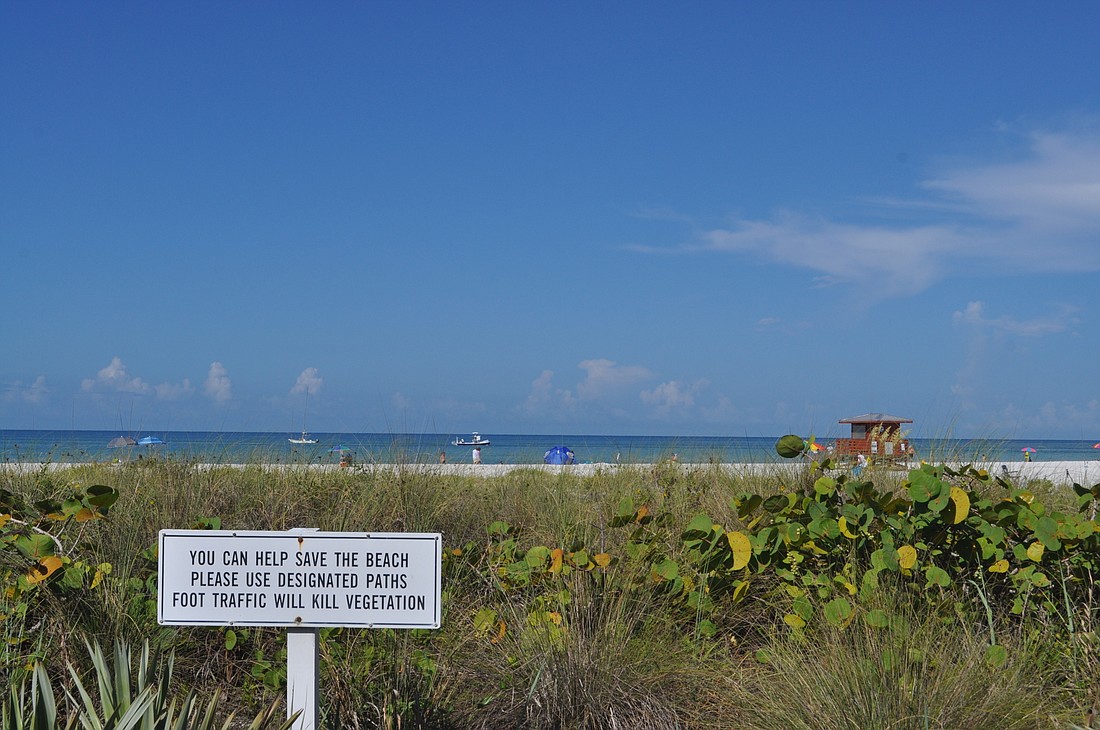- May 4, 2024
-
-
Loading

Loading

Where some people might have just seen a few downed rope barriers along the multi-use recreational trail leading to the beach on Lido Key, Carl Shoffstall saw a bigger problem.
Shoffstall, president of the Lido Key Residents Association, noticed that wherever the ropes were removed, beachgoers started deviating from the established paths, traveling over the sand dunes to take the most direct route to the water.
“When the rope went down, people saw an easy access to go to the beach,” Shoffstall said. “I've been watching it, and people started to walk across just to make it easier for them to get to the beach — walking across the vegetation and everything.”
Earlier this month, Shoffstall reached out to county officials in an attempt to get the rope replaced as soon as possible. In addition to the effect people might have on the natural environment along the dunes, Shoffstall was intent on preserving the integrity of the dunes themselves.
In an area with a critically eroded shoreline, with the county and the city teaming up earlier this year to restore sand lost during Tropical Storm Debby in 2012, the sandy reserves are a valuable resource.
“We're trying to keep everybody off the dunes,” Shoffstall said. “The dunes are the protection for Lido, in case there’s a storm or something. It’s holding the beach.”
"The dunes are the protection for Lido." — Carl Shoffstall
Although replacing a rope is a relatively easy fix — one the county was able to act on a couple of weeks after Shoffstall’s message — it doesn’t end the threat to the dunes on Lido Beach. George Tatge, the county’s manager of beaches and water access parks, said that this problem has existed in one form or another for the entirety of his 15-year tenure.
“People are always looking for the shortest distance between them and the water’s edge,” Tatge said. “That’s the problem we're trying to solve — providing safe and environmentally healthy access to the water.”
In detailing the value of the dunes, Tatge reiterated Shoffstall’s point that it was an important backup sand source in the event of a tropical storm. Additionally, it’s a crucial part of the beach ecosystem for animals and plants in the area.
“It provides a space for our beach wildlife to forage, to hunker down in times of danger,” Tatge said. “It's a wildlife habitat.”
Although the problem might have been more pronounced when the rope was down, it hasn't been eliminated now that it’s back up. Tatge said people often climb over a 3-foot retaining wall blocking off access to the dunes just to take advantage of the shortest route to the beach. That adds another dimension to the issue: Someone not utilizing the proper path to the beach becomes a safety hazard, as well.
“The water out there is very great for some people, and they're too excited and can't seem to find the appropriate way around to the water,” Tatge said.
"That’s the problem we're trying to solve — providing safe and environmentally healthy access to the water." — George Tatge
He’s working alongside the city on some potential solutions for addressing this ongoing problem. One of those solutions is educating the average beachgoer about the right and wrong ways to access the beach. Tatge thinks the signage that’s already in place could be clearer: It informs people that they should access the beach on designated trails only, but there’s no additional information on what, exactly, a designated trail is.
“We put this sign up to block the trail, and people could think that's where the designated trail is,” Tatge said.
To fix that problem, Tatge suggests a more formal naming designation for the beach access points on Lido, similar to those in place on Siesta Key Beach. By compiling a comprehensive wayfinding map with a detailed listing of which access points were and weren’t OK to use, Tatge hopes the dunes will have less feet trampling atop them.
As Siesta Key Beach has gotten wider over the past several years, Tatge mentioned that beachgoers sometimes have a difficult time lugging all of their gear near the water. Still, at that beach, the county hasn’t observed the same problems that have plagued Lido for more than a decade.
“Now that they just nourished Lido, it’s still not a wide beach,” Tatge said. “There really is no excuse for taking that shortcut. They just need to use the designated trails.”